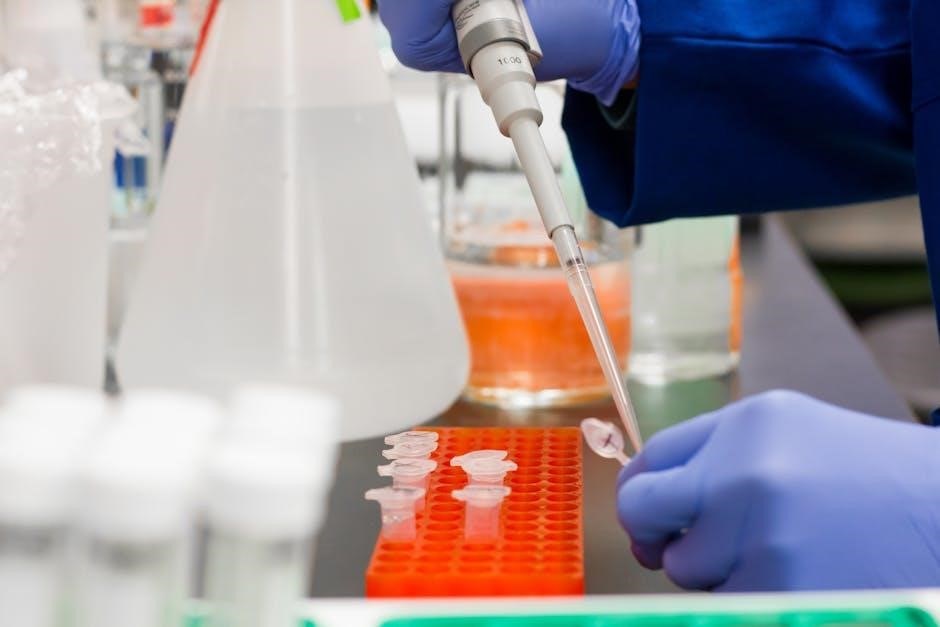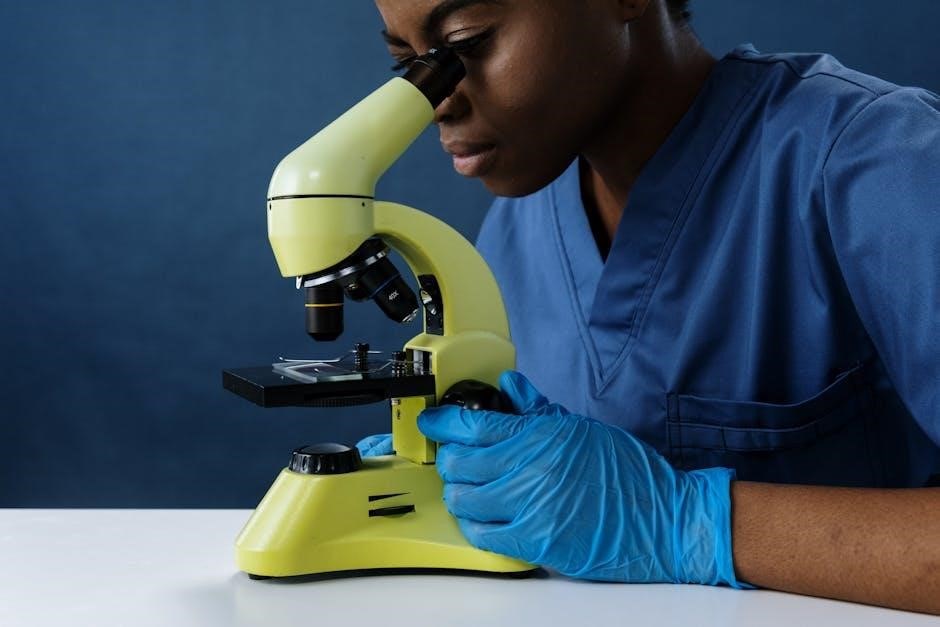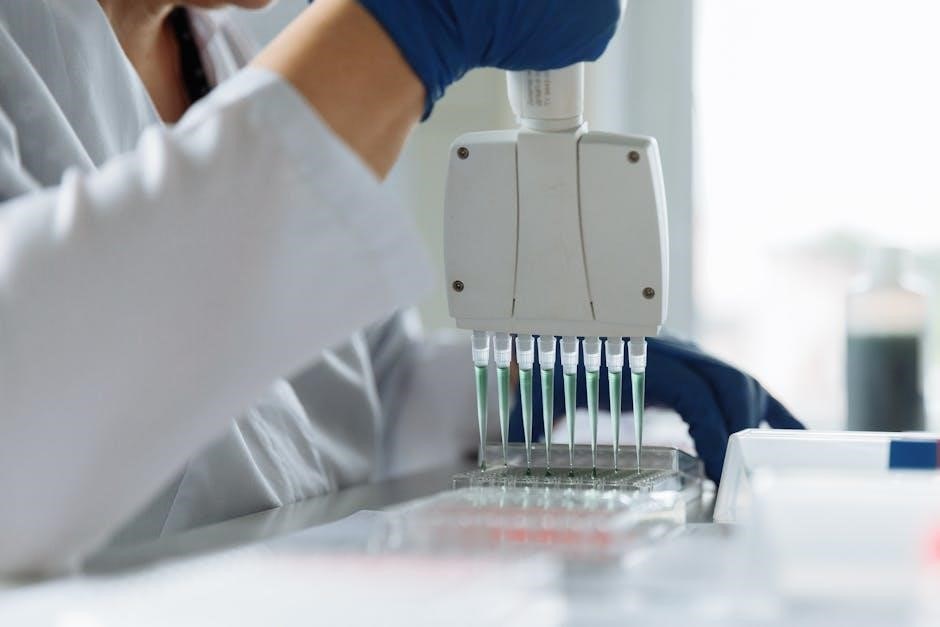
microbiology an evolving science 5th edition pdf
The 5th Edition of Microbiology: An Evolving Science by Joan L. Slonczewski, John W. Foster, and Erik R. Zinser offers a balanced approach to teaching microbiology, blending cutting-edge research with foundational concepts. Published by W.W. Norton & Company, this textbook is designed for undergraduate students, providing engaging examples and updated content in genetics, genomics, and active learning resources. It serves as a dynamic resource for both instructors and students, reflecting the rapid advancements in the field while maintaining clarity and accessibility.
1.1 Background and Overview
Microbiology: An Evolving Science, 5th Edition, authored by Joan L. Slonczewski, John W. Foster, and Erik R. Zinser, is a comprehensive undergraduate textbook published by W.W. Norton & Company. First released in 2020, it has become a cornerstone in microbiology education, blending foundational concepts with cutting-edge research. The text is structured to engage students while addressing the rapid advancements in the field. It features updated genetics and genomics content, eye-catching visuals, and innovative digital tools like Smartwork5. Designed for microbiology majors, the book balances depth with accessibility, making it a valuable resource for both students and instructors. Its dynamic approach reflects the evolving nature of microbiology, ensuring relevance in a fast-paced scientific landscape.
1.2 Key Features of the 5th Edition
The 5th Edition of Microbiology: An Evolving Science introduces several key enhancements. It includes updated genetics and genomics content, contributed by new coauthor Erik R. Zinser, ensuring students are exposed to the latest advancements. The textbook features an improved art program with engaging visuals and figures that enhance understanding. Additionally, it offers an innovative media package and active learning resources, providing flexible options for both in-class and out-of-class assessment. The Smartwork5 course has been updated, offering interactive tools to supplement traditional learning. These features collectively create a dynamic and student-friendly experience, making the 5th Edition a robust educational resource for microbiology students and instructors alike.

Part I: The Microbial Cell
Part I explores the microbial cell, focusing on its structure, function, and discovery. Chapters cover the origin of microbial life and advanced techniques for observing microorganisms in detail.
2.1 Chapter 1: Microbial Life: Origin and Discovery
Chapter 1 delves into the origins of microbial life, exploring the earliest evidence of microorganisms and their role in shaping Earth’s ecosystems. It traces the history of microbial discovery, from Antonie van Leeuwenhoek’s pioneering microscopy to modern genomic techniques. The chapter highlights how these discoveries have illuminated microbial diversity, adaptation, and evolution. Key concepts include the microbial world’s antiquity and its foundational role in life on Earth. This section provides a comprehensive foundation for understanding the significance of microbes in biology and their ongoing impact on scientific research and human health.
2.2 Chapter 2: Observing the Microbial Cell
Chapter 2 focuses on the methods and techniques used to observe and study microbial cells. It explores the history and development of microscopy, from light microscopy to advanced electron microscopy, and their roles in revealing microbial structures. The chapter also covers staining techniques, including Gram staining, and how they help differentiate microbial species. Modern imaging technologies, such as fluorescence microscopy, are discussed, highlighting their importance in visualizing microbial cells in detail. This section emphasizes the significance of observation in understanding microbial morphology, physiology, and ecology, providing students with a solid foundation for further studies in microbiology.

Microbial Genetics and Genomics
This section explores the fundamental principles of microbial genetics and genomics, emphasizing how genetic processes shape microbial behavior, adaptation, and evolution. The 5th Edition incorporates cutting-edge research in genomics, highlighting advancements in sequencing technologies and their applications in understanding microbial diversity and function. It also delves into gene regulation, mutation, and recombinant DNA technology, providing a comprehensive foundation for students to grasp the genetic basis of microbial life and its relevance to modern microbiology.
3.1 Key Concepts in Microbial Genetics
This section covers the core principles of microbial genetics, including DNA structure, gene expression, and regulation. It explores mutation, genetic recombination, and the mechanisms of bacterial transformation. The chapter emphasizes how microorganisms adapt through genetic processes, such as horizontal gene transfer and the role of CRISPR systems. Key concepts like operons, gene regulation, and the genetics of viral replication are also discussed. The 5th Edition integrates modern advances, such as genomics and bioinformatics, to illustrate how genetic information shapes microbial behavior and evolution. These concepts are essential for understanding microbial diversity, pathogenesis, and biotechnological applications, providing a solid foundation for further study in microbiology.
3.2 Advances in Genomics and Their Impact
Recent advancements in genomics have revolutionized the understanding of microbial diversity, evolution, and interactions. High-throughput sequencing and bioinformatics tools enable comprehensive analysis of microbial genomes, revealing insights into gene function, regulation, and adaptation. The 5th Edition highlights these breakthroughs, emphasizing metagenomics and its role in studying microbial communities. Genomic data has also accelerated vaccine development, antimicrobial resistance tracking, and biotechnological innovations. These advances provide a deeper understanding of microbial ecology and pathogenesis, offering practical applications in medicine, agriculture, and environmental science. The integration of genomics in microbiology education underscores its transformative impact on research and real-world problem-solving, making it a cornerstone of modern microbiological study.

Microbial Metabolism and Biochemistry
Microorganisms have evolved unique metabolic strategies to thrive in diverse environments, utilizing various substrates and synthesizing essential nutrients, which are crucial for their survival and adaptation.
4.1 Core Metabolic Pathways
Core metabolic pathways are essential for microbial survival, enabling energy production and the synthesis of vital organic molecules. These pathways, such as glycolysis, the TCA cycle, and fermentation, are conserved across many microorganisms and form the foundation of microbial biochemistry. The 5th Edition of Microbiology: An Evolving Science provides detailed insights into these processes, emphasizing their role in microbial adaptation to diverse environments. The textbook highlights how these pathways are regulated and how they interact to maintain cellular homeostasis. Engaging diagrams and case studies illustrate the importance of these pathways in microbial physiology, making complex biochemical concepts accessible to students. This section is crucial for understanding microbial metabolism.
4.2 Biochemical Adaptations in Microorganisms
Microorganisms exhibit remarkable biochemical adaptations that enable them to thrive in diverse and extreme environments. These adaptations include unique metabolic pathways, such as methanogenesis, nitrogen fixation, and the use of alternative energy sources like sulfur or iron. The 5th Edition of Microbiology: An Evolving Science explores how these specialized processes allow microbes to colonize niches that would be hostile to most other life forms. The textbook highlights examples such as thermophiles, halophiles, and acidophiles, detailing their biochemical strategies for survival; These adaptations not only demonstrate microbial diversity but also underscore their critical roles in ecosystem functioning and biotechnological applications, making them a fascinating area of study in modern microbiology.
Microbial Ecology and Environmental Interactions
Microbial Ecology and Environmental Interactions explores how microorganisms interact with their environments and other organisms, shaping ecosystems and influencing processes like nutrient cycling, decomposition, and climate regulation.
5.1 Microbial Communities and Ecosystems
Microbial communities are complex assemblages of microorganisms that interact within specific environmental niches, playing vital roles in ecosystem functioning. These communities are characterized by their diversity, structural organization, and metabolic interactions, which enable them to thrive in various habitats. Microorganisms contribute to essential ecological processes such as nutrient cycling, decomposition, and the production of atmospheric gases. The 5th Edition of Microbiology: An Evolving Science emphasizes the interconnectedness of microbial life with broader ecological systems, highlighting how these interactions shape both the environment and the microorganisms themselves. This section explores the dynamics of microbial ecosystems, their adaptability, and their significance in maintaining global ecological balance.
5.2 Environmental Roles and Applications
Microorganisms play pivotal roles in various environmental processes, offering practical applications in bioremediation, agriculture, and conservation. The 5th Edition of Microbiology: An Evolving Science highlights their use in cleaning pollutants, enhancing soil fertility, and producing biofuels. These microbes are employed to degrade toxic chemicals, restore ecosystems, and promote sustainable practices. Their versatility extends to industrial processes, such as waste treatment and resource recovery, underscoring their importance in addressing global environmental challenges. This section emphasizes the real-world applications of microbial science, illustrating how microorganisms contribute to solving critical ecological issues while advancing green technologies.
Microbial Pathogenesis and Immunology
This section explores the mechanisms by which microorganisms cause disease and the strategies hosts use to combat infections, emphasizing the dynamic interplay between pathogens and the immune system.
6.1 Mechanisms of Pathogenesis
Mechanical and chemical strategies are used by microorganisms to invade and colonize host environments, producing disease. This section examines how pathogens adhere to host cells, produce toxins, and evade immune responses. Key mechanisms include biofilm formation, enzyme secretion, and manipulation of host signaling pathways. Understanding these processes is critical for developing therapeutic interventions. The textbook provides detailed insights into how pathogens exploit host systems, supported by engaging examples and updated research findings, offering a comprehensive view of microbial strategies and their impact on human health. This chapter equips students with a solid understanding of the intricate interactions between microbes and their hosts.
6.2 Host-Microbe Interactions and Immune Response
This section explores the complex relationships between microorganisms and their hosts, focusing on how the immune system responds to pathogens. It delves into mechanisms such as phagocytosis, cytokine signaling, and antibody production, highlighting how the immune system distinguishes harmful microbes from beneficial ones; The textbook emphasizes the role of the microbiome in shaping immune responses and maintaining health. By examining these interactions, students gain insights into how the immune system balances defense against pathogens while tolerating commensal microorganisms. This understanding is crucial for developing strategies to combat infectious diseases and immune disorders, making it a cornerstone of microbiological studies. The content is supported by engaging examples and updated research findings.

Applied Microbiology
Applied microbiology explores the practical uses of microorganisms in industries, medicine, and environmental science, showcasing their roles in biotechnology, food production, and public health advancements.
7.1 Industrial and Biotechnological Applications
Microorganisms are pivotal in industrial processes, producing enzymes, organic acids, and bioactive compounds. The 5th Edition highlights their role in biofuel production, enhancing sustainability. Food processing relies on microbial fermentation for products like yogurt and cheese. Industrial applications extend to pharmaceuticals, where microbes synthesize antibiotics and vaccines. Biotechnological advancements, such as genetic engineering, optimize microbial production systems. Environmental biotechnology leverages microbes for bioremediation, cleaning pollutants. These applications underscore microbiology’s critical role in advancing industries and addressing global challenges, demonstrating how microbial science drives innovation and supports sustainable practices across sectors. The text emphasizes real-world examples, illustrating the vast potential of microorganisms in solving industrial and environmental problems.
7.2 Medical Applications and Public Health
Microbiology plays a vital role in medicine and public health, driving advancements in disease prevention and treatment. The 5th Edition emphasizes microbial contributions to vaccine development, diagnostics, and antimicrobial therapies; Public health relies on microbiological surveillance to track pathogens and control outbreaks. Microbes are also engineered for producing therapeutic proteins and antibiotics. The text highlights how microbiological research informs strategies to combat infectious diseases, ensuring global health security. These applications underscore the importance of microbiology in safeguarding human health and preventing future pandemics through innovative solutions and evidence-based practices. The integration of microbiology in medicine continues to save lives and improve healthcare outcomes worldwide.

Microbial Evolution and Systematics
Microbial evolution and systematics explore how microorganisms diversify and relate. The 5th Edition integrates genetic and genomic insights, advancing our understanding of microbial ancestry and classification.
8.1 Evolutionary Processes in Microorganisms
Microorganisms undergo rapid evolutionary processes due to their short generation times and genetic flexibility. Mutation, gene transfer, and natural selection drive microbial adaptation. The 5th Edition highlights how these mechanisms enable microbes to evolve swiftly, developing resistance to antibiotics and thriving in diverse environments. Advances in genomics reveal phylogenetic relationships and evolutionary histories, offering insights into how microbes acquire and share genetic material. These processes are crucial for understanding microbial diversity, pathogenesis, and ecological roles. The text emphasizes the importance of evolutionary principles in explaining microbial survival and adaptation, providing a foundation for studying systematics and microbial evolution.
8.2 Taxonomy and Phylogeny
Taxonomy and phylogeny are essential for understanding microbial diversity and relationships. The 5th Edition emphasizes advances in molecular methods, such as 16S rRNA sequencing, which have revolutionized microbial classification. These techniques, combined with genomics, provide deeper insights into phylogenetic relationships, enabling more accurate taxonomic groupings. The integration of molecular data has led to significant updates in bacterial and archaeal classification systems. These changes reflect the dynamic nature of microbial taxonomy, which continues to evolve as new species and genomic information are discovered. The text highlights how modern taxonomy informs fields like environmental microbiology and public health, underscoring the importance of accurate classification in understanding microbial roles and interactions.

Emerging Trends in Microbiology
The 5th Edition highlights cutting-edge advancements, including CRISPR technology, microbiome research, and antimicrobial resistance. These emerging trends showcase microbiology’s rapid evolution and its impact on medicine and sustainability.
9.1 Current Research and Innovations
Current research in microbiology, as highlighted in the 5th Edition, focuses on advancements like CRISPR technology, microbiome studies, and antimicrobial resistance. These innovations underscore the field’s rapid evolution. The textbook emphasizes updated genetics and genomics content, particularly with contributions from Erik Zinser, reflecting modern discoveries. Emerging trends include the exploration of microbial communities and their roles in ecosystems, as well as breakthroughs in industrial and medical applications. Such research not only deepens our understanding of microorganisms but also opens new avenues for addressing global health challenges and environmental sustainability, making microbiology a dynamic and indispensable field of study in the 21st century.
9.2 The Future of Microbiology
The future of microbiology is poised for transformative growth, driven by advancements in CRISPR technology, microbiome research, and artificial intelligence. As highlighted in the 5th Edition, emerging trends like precision medicine and microbial biotechnology will reshape healthcare and environmental science. The integration of microbiology with other disciplines, such as bioinformatics and nanotechnology, promises innovative solutions to global challenges. Future research will likely focus on understanding microbial interactions, combating antimicrobial resistance, and harnessing microorganisms for sustainable energy and agriculture. These developments underscore microbiology’s critical role in addressing societal needs, ensuring its continued relevance and expansion in the coming decades.
Publication and Edition Details
Microbiology: An Evolving Science, 5th Edition, authored by Joan L. Slonczewski, John W. Foster, and Erik R. Zinser, is published by W.W; Norton & Company (2020). ISBN: 9780393419962.
10.1 Publisher and Authors
The 5th Edition of Microbiology: An Evolving Science is published by W.W. Norton & Company, a renowned publisher of academic texts. The authors, Joan L. Slonczewski, John W. Foster, and Erik R. Zinser, bring extensive expertise in microbiology, with Joan L. Slonczewski specializing in microbial physiology and genetics, John W. Foster in microbial physiology and metabolism, and Erik R. Zinser contributing cutting-edge insights in genomics. Their collaborative effort ensures a balanced blend of modern research and foundational concepts, making the textbook a trusted resource for undergraduate microbiology education. The publisher’s commitment to quality and the authors’ expertise have cemented this edition’s reputation as a leading textbook in the field.
10.2 Edition Updates and Improvements
The 5th Edition of Microbiology: An Evolving Science introduces significant enhancements, including the addition of coauthor Erik R. Zinser, who brings expertise in genomics. The textbook features updated genetics and genomics content, reflecting the latest advancements in these fields. The art program has been comprehensively revised, offering clearer and more engaging visual aids. Additionally, the Smartwork5 course has been updated, and new active learning resources have been incorporated to support flexible assessment options. These improvements aim to provide students with a dynamic and interactive learning experience while maintaining the text’s authority and readability. The updates ensure the textbook remains a cutting-edge resource for undergraduate microbiology education.

Educational Resources and Supplements
Microbiology: An Evolving Science, 5th Edition offers a companion website, study materials, and digital learning platforms to enhance student engagement and understanding of microbiological concepts.
11.1 Companion Websites and Study Materials
The 5th Edition of Microbiology: An Evolving Science is supported by a comprehensive companion website and extensive study materials. These resources include interactive exercises, quizzes, and multimedia content designed to enhance student engagement and understanding. The website features Smartwork5, an updated online course with assignments and simulations that reinforce key microbiological concepts. Additionally, instructors and students can access downloadable slides, study guides, and active learning resources. These supplements are tailored to complement the textbook, providing a well-rounded educational experience that fosters both independent study and classroom learning. The materials are regularly updated to reflect advancements in the field, ensuring relevance and accuracy.
11.2 Digital Learning Platforms and Tools
The 5th Edition of Microbiology: An Evolving Science integrates with innovative digital learning platforms to enhance student engagement and understanding. Smartwork5, an updated online course, offers interactive simulations, quizzes, and homework assignments tailored to microbiological concepts. These tools encourage active learning and provide immediate feedback, helping students master complex topics. The platform also includes multimedia resources, such as animations and videos, to visualize microbial processes. Additionally, the digital tools are accessible on multiple devices, allowing students to study flexibly. These resources are designed to complement the textbook, fostering a deeper understanding of microbiology through interactive and immersive learning experiences. They cater to diverse learning styles and preferences, ensuring comprehensive student support.

Reviews and Reception
Microbiology: An Evolving Science, 5th Edition has received positive feedback from students and educators. It balances cutting-edge research with foundational concepts, praised for its clarity and engaging examples. The updated Smartwork5 course and active learning resources enhance its educational value, making it a valuable resource for undergraduate microbiology studies.
12.1 Academic and Student Feedback
Academics and students have praised the 5th Edition of Microbiology: An Evolving Science for its engaging and accessible approach. Educators appreciate how the text balances cutting-edge research with foundational concepts, while students highlight its readability and visual appeal. The updated Smartwork5 course and active learning resources have been particularly well-received, offering flexible options for assessment and engagement; Many reviewers note that the inclusion of new coauthor Erik Zinser has strengthened the genetics and genomics content, making the text more comprehensive. Overall, the 5th Edition is widely regarded as a valuable resource for undergraduate microbiology education, effectively meeting the needs of both instructors and learners.
12.2 Impact on Microbiology Education
The 5th Edition of Microbiology: An Evolving Science has significantly influenced microbiology education by providing a dynamic and comprehensive resource for undergraduate students. Its balanced approach to conveying cutting-edge research alongside foundational concepts has made it a preferred choice for instructors. The integration of updated genetics and genomics content, along with innovative active learning tools, has enhanced student engagement and understanding. The textbook’s clarity and accessibility have set a new standard in microbiology education, ensuring that students are well-prepared to tackle the challenges of this rapidly advancing field. Its widespread adoption underscores its importance as a cornerstone of modern microbiology curricula.

Accessing the Textbook
The 5th Edition of Microbiology: An Evolving Science is available for purchase, rent, or digital download through platforms like Amazon, eBooks.com, and the publisher’s official website.
13.1 Purchase and Rental Options
Students and educators can access Microbiology: An Evolving Science, 5th Edition through various purchase and rental options. The textbook is available in paperback and digital formats from major retailers like Amazon, Barnes & Noble, and eBooks.com. Rental options offer cost-effective solutions for those preferring temporary access. Additionally, the publisher’s website provides direct purchase options, ensuring authenticity and convenience. Digital versions, including PDF, are accessible via platforms like eBookMaster and Direct Textbook, catering to diverse learning preferences. These options make the textbook widely accessible, supporting both individual and institutional needs while maintaining affordability and flexibility for users.
13.2 Digital Versions and Availability
Digital versions of Microbiology: An Evolving Science, 5th Edition are widely available, offering flexibility for modern learners. The PDF version can be downloaded from platforms like eBookMaster and eTextbook websites, ensuring easy access. Additionally, the textbook is accessible through digital learning platforms, providing interactive features and multimedia resources. Students can also rent or purchase digital copies through services like Amazon Kindle and Google Play Books. Many universities and libraries offer e-book access, further enhancing availability. These digital formats cater to diverse learning styles, enabling users to study efficiently on various devices, anytime and anywhere, while staying updated with the latest in microbiology education.
Microbiology: An Evolving Science, 5th Edition is a comprehensive and dynamic resource that effectively bridges cutting-edge research with foundational microbiology concepts, making it indispensable for undergraduate students and educators alike.
14.1 Summary of Key Points
Microbiology: An Evolving Science, 5th Edition provides a comprehensive overview of microbiology, balancing cutting-edge research with foundational concepts. Authored by Joan L. Slonczewski, John W. Foster, and Erik R. Zinser, the textbook is tailored for undergraduate students, offering engaging examples and updated content in genetics, genomics, and active learning resources. It includes a revised art program, Smartwork5 course updates, and new coauthor contributions, ensuring a dynamic and accessible learning experience. The 5th Edition emphasizes the rapid advancements in microbiology while maintaining clarity, making it an essential resource for both students and instructors in the field.
14.2 Final Thoughts on the 5th Edition
The 5th Edition of Microbiology: An Evolving Science stands out as a premier undergraduate textbook, effectively bridging research advancements with core microbiological principles. With contributions from renowned authors Joan L. Slonczewski, John W. Foster, and Erik R. Zinser, the text offers a student-friendly approach through engaging examples, updated visuals, and innovative digital tools. Its balanced presentation makes it an invaluable resource for both educators and students, ensuring a deep understanding of microbiology’s dynamic landscape. The integration of new coauthor expertise and active learning resources underscores its commitment to fostering a comprehensive and engaging educational experience in this rapidly evolving field.